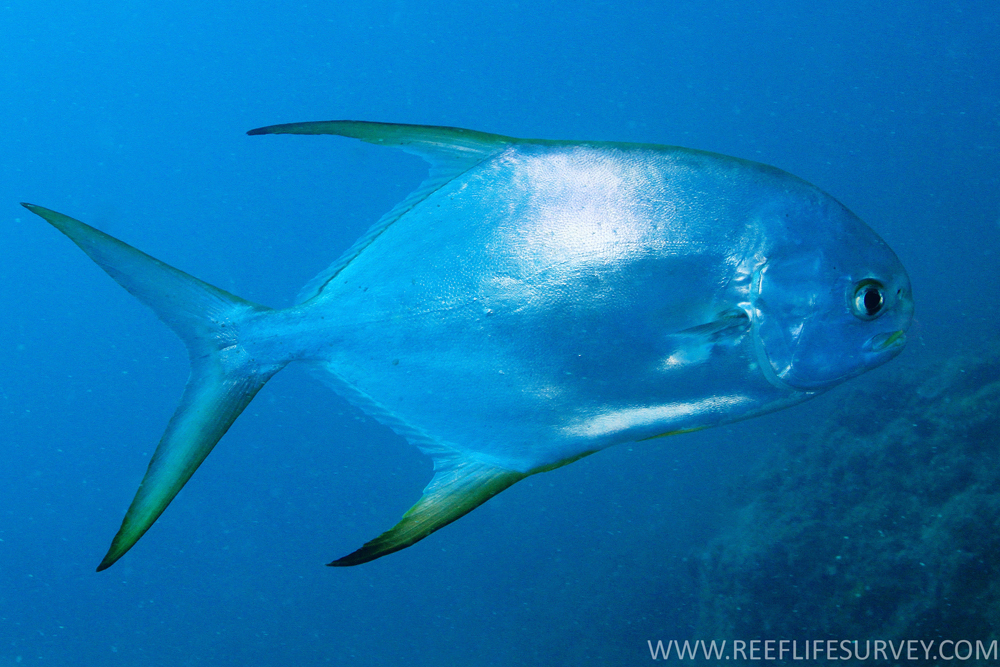Snubnose Dart, Trachinotus blochii (Lacépède 1801)

A Snubnose Dart, Trachinotus blochii, on the Great Barrier Reef, Queensland. Source: Graham Edgar / Reef life Survey. License: CC By Attribution
Snubnose Dart, Trachinotus blochii (Lacépède 1801)
More Info
|
Distribution |
Shark Bay region and offshore reefs of north Western Australia, around the tropical north to Batemans Bay, New South Wales on the southeast coast; also Cocos (Keeling) Islands in the eastern Indian Ocean, and the Lord Howe Province and Norfolk Island in the Tasman Sea. Elsewhere, the species is widespread in the tropical Indo-west-central Pacific. Inhabits shallow coastal waters, usually close to reefs, often along reef margins. Juveniles usually school in shallow sandy and muddy areas, often around river mouths, and along sandy shores. |
|
Features |
Dorsal fin VI (short, often embedded) + I,18-20; Anal fin I,16-18.Snout profile broadly rounded; tongue toothless (except 2–3 slender teeth rarely on small specimens). |
|
Colour |
Head and body bluish-grey above, paler below; large adults sometimes with most of body golden-orange, especially snout and lower half of body; 2nd dorsal fin dark, fin lobe dusky orange; caudal fin dark to dusky orange, leading edges darkest; juveniles silvery with pale fins except brownish to dusky orange lobes of median fins and anterior half of pelvic fins. |
|
Feeding |
Feeds on hard-shelled molluscs and other invertebrates. |
|
Fisheries |
Of minor commercial importance, particularly in artisanal fisheries, and aquacultured in some areas. Also a popular sports fish and displayed in public aquaria. |
|
Similar Species |
The similar Giant Oyster Cracker, Trachinotus anak, has shorter dorsal and anal-fin lobes in adults, and lacks the dark leading edges and black margin on the caudal-fin lobes of the Snubnose Dart. |
|
Etymology |
The species is presumably named for the physician-naturalist Marcus Elieser Bloch, a prominent 18th century ichthyologist. |
|
Species Citation |
Caesiomorus blochii Lacépède 1801, Histoire Naturelle des Poissons 3: 92, 95, pl. 3(2). Type locality: not stated in publication (= Fort Dauphin, near Tôlanaro, southeastern Madagascar). |
|
Author |
Bray, D.J. 2022 |
|
Resources |
Snubnose Dart, Trachinotus blochii (Lacépède 1801)
References
Allen, G.R. 1997. Marine Fishes of Tropical Australia and South-east Asia. Perth : Western Australian Museum 292 pp. 106 pls.
Allen, G.R. & Erdmann, M.V. 2012. Reef fishes of the East Indies. Perth : Tropical Reef Research 3 vols, 1260 pp.
Allen, G.R. & Smith-Vaniz, W.F. 1994. Fishes of Cocos (Keeling) Islands. Atoll Research Bulletin 412: 1-21.
Allen, G.R. & Swainston, R. 1988. The Marine Fishes of North-Western Australia. A field guide for anglers and divers. Perth, WA : Western Australian Museum vi 201 pp., 70 pls.
Blaber, S.J.M., Young, J.W. & Dunning, M.C. 1985. Community structure and zoogeographic affinities of the coastal fishes of the Dampier region of north-western Australia. Australian Journal of Marine and Freshwater Research 36: 247-266. https://doi.org/10.1071/MF9850247
Francis, M.P. 1991. Additions to the fish faunas of Lord Howe, Norfolk and Kermadec Islands, Southwest Pacific Ocean. Pacific Science 45(2): 204-220.
Francis, M. 1993. Checklist of the coastal fishes of Lord Howe, Norfolk, and Kermadec Islands, southwest Pacific Ocean. Pacific Science 47(2): 136-170 figs 1-2.
Grant, E.M. 1975. Guide to Fishes. Brisbane : Queensland Government, Co-ordinator General’s Department 640 pp.
Grant, E.M. 2002. Guide to Fishes. Redcliffe : EM Grant Pty Ltd 880 pp.
Johnson, J.W. 2010. Fishes of the Moreton Bay Marine Park and adjacent continental shelf waters, Queensland, Australia. pp. 299-353 in Davie, P.J.F. & Phillips, J.A. Proceedings of the Thirteenth International Marine Biological Workshop, The Marine Fauna and Flora of Moreton Bay. Memoirs of the Queensland Museum 54(3)
Kuiter, R.H. 1993. Coastal Fishes of South-eastern Australia. Bathurst : Crawford House Press 437 pp.
Kuiter, R.H. 1996. Guide to Sea Fishes of Australia. A comprehensive reference for divers and fishermen. Sydney, NSW, Australia : New Holland Publishers xvii, 434 pp.
Lacépède, B.G. 1801. Histoire Naturelle des Poissons. Paris : chez Plassan Vol. 3 558 pp. 34 pls. See ref at BHL
Larson, H.K., Williams, R.S. & Hammer, M.P. 2013. An annotated checklist of the fishes of the Northern Territory, Australia. Zootaxa 3696(1): 1-293
Prokop, F. 2002. Australian Fish Guide. Croydon South, Victoria : Australian Fishing Network 256 pp.
Randall, J.E. 2005. Reef and shore fishes of the South Pacific. New Caledonia to Tahiti and the Pitcairn Islands. University of Hawaii Press, Honolulu, Hawaii. 720 pp.
Randall, J.E., Allen, G.R. & Steene, R. 1990. Fishes of the Great Barrier Reef and Coral Sea. Bathurst : Crawford House Press 507 pp. figs.
Randall, J.E., Allen, G.R. & Steene, R. 1997. Fishes of the Great Barrier Reef and Coral Sea. Bathurst : Crawford House Press 557 pp. figs.
Russell, B.C. 1983. Annotated checklist of the coral reef fishes in the Capricorn-Bunker group, Great Barrier Reef, Australia. Great Barrier Reef Marine Park Authority. Special Publication Series 1: 1-184 figs 1-2.
Smith-Vaniz, W.F. 1999. Family Carangidae. pp. 2659-2756 in Carpenter, K.E. & Niem, T.H. (eds). The Living Marine Resources of the Western Central Pacific. FAO Species Identification Guide for Fisheries Purposes. Rome : FAO Vol. 4 2069-2790 pp.
Smith-Vaniz, W.F. & Walsh, S.J. 2019. Indo-West Pacific species of Trachinotus with spots on their sides as adults, with description of a new species endemic to the Marquesas Islands (Teleostei: Carangidae). Zootaxa 4651(1): 1-37. http://dx.doi.org/10.11646/zootaxa.4651.1.1
Smith-Vaniz, W.F. & Williams, I. 2016. Trachinotus blochii (errata version published in 2017). The IUCN Red List of Threatened Species 2016: e.T20436497A115384558. https://dx.doi.org/10.2305/IUCN.UK.2016-3.RLTS.T20436497A46664144.en. Downloaded on 21 June 2021.
Yearsley, G.K., Last, P.R. & Ward, R.D. (eds) 1999. Australian Seafood Handbook. Hobart : CSIRO Marine Research 460 pp.









